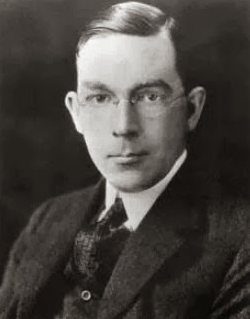Biography:Leonard T. Troland
Leonard T. Troland | |
|---|---|
 | |
| Born | April 26, 1889 Norwalk, Connecticut |
| Died | May 1932 (aged 43) |
| Scientific career | |
| Fields | Physics, psychology |
Leonard Thompson Troland (1889–1932) was an American physicist, psychologist and psychical researcher.[1][2]
Career
Troland graduated in 1912 from the Massachusetts Institute of Technology with a degree in biochemistry. He then studied psychology at Harvard University, where he obtained a Ph.D. in 1915. He worked for a year as a Harvard Travelling fellow at the General Electric Nela research lab. He served as a member of committees of the National Research Council on vision and aviation psychology. At Harvard, he gave advanced courses in psychology, and he followed up his 1926 book The Mystery of Mind with Fundamentals in Human Motivation in 1928. At the same time, he was chief engineer of the Technicolor Motion Picture Corporation of California and was appointed director of research at Technicolor in 1925.[3]
He was elected to serve as president of the Optical Society of America from 1922 to 1923.[4]
He gave his name to the troland (symbol Td), the unit of conventional retinal illuminance. It is meant as a method for correcting photometric measurements of luminance values impinging on the human eye by scaling them by the effective pupil size.
The National Academy of Sciences gives an award on his behalf.
In 1932, he fell to his death from the observatory near Pasadena CA, Mount Wilson.[5][6][7] [8]
Psychical research
Troland took interest in psychical research and had carried out experiments in telepathy at Harvard University which were reported in 1917.[9][10][11][12] He was one of the first scientists to use a machine in this type of experiment instead of a human experimenter. The machine consisted of a lamp which when triggered would light either of two square blocks. The agent would attempt to perceive the light in one room while the receiver would use a switch to identify which lamp had been lit in the other room. Troland discovered that the subjects had produced below chance expectations.[13]
Publications
- A Technique for the Experimental Study of Telepathy and Other Alleged Clairvoyant Processes (1917)
- The Nature of Matter and Electricity: An Outline of Modern Views [with Daniel Frost Comstock] (1917)
- The Mystery of Mind (1926)
- The Fundamentals of Human Motivation (1928)
See also
- Optical Society of America
- Troland Research Awards
References
- ↑ Beebe-Center, J. G. (1932). Leonard Thompson Troland: 1889-1932. American Journal of Psychology 44: 817-820
- ↑ Roback, A. A. (1932). Leonard Thompson Troland. Science 76: 26-27.
- ↑ Profile of Leonard T. Troland
- ↑ "Past Presidents of the Optical Society of America". Optical Society of America. Archived from the original on 2009-01-20. https://web.archive.org/web/20090120044158/http://osa.org/aboutosa/leadership/pastpresidents/default.aspx.
- ↑ "Harvard Scientist Topples to Death". Lewiston Daily Sun. May 28, 1932. https://news.google.com/newspapers?nid=1928&dat=19320528&id=o8ggAAAAIBAJ&pg=2697,4708276. Retrieved August 28, 2013.
- ↑ "Noted Scientist Killed in Fall Over Precipice". Meriden Record. May 28, 1932. https://news.google.com/newspapers?id=wKdHAAAAIBAJ&pg=4983,2060363&dq=leonard+troland&hl=en. Retrieved August 28, 2013.
- ↑ Letters Leonard Thompson Troland
- ↑ "TROLAND'S DEATH ACCIDENT; Los Angeles Sheriff Ends Inquiry Into Fall Over Cliff." (in en). The New York Times. http://timesmachine.nytimes.comhttp//timesmachine.content-tagging.us-east-1-01.prd.dvsp.nyt.net/timesmachine/1932/05/29/100749663.html?pageNumber=6.
- ↑ Christopher, Milbourne. (1971). ESP, Seers & Psychics. Crowell. p. 19. ISBN:978-0-690-26815-7
- ↑ Berger, Arthur S. (1988). Lives and Letters in American Parapsychology: A Biographical History, 1850-1897. McFarland. p. 66. ISBN:0-89950-345-4
- ↑ Luckhurst, Roger. (2002). The Invention of Telepathy: 1870-1901. Oxford University Press. p. 269. ISBN:978-0199249626
- ↑ Hannan, Caryn. (2008 edition). Connecticut Biographical Dictionary. State History Publications. p. 526. ISBN:1-878592-72-6 "On his return to Harvard in 1916, one of his first enterprises was an investigation of telepathy in the psychology laboratory, which gave negative results."
- ↑ Asprem, Egil. (2014). The Problem of Disenchantment: Scientific Naturalism and Esoteric Discourse, 1900-1939. Brill Academic Publishers. pp. 362-364. ISBN:978-9004251922
External links
- Articles Published by early OSA Presidents – Journal of the Optical Society of America
- Trolands Research Awards
- Leonard Troland and the Story of the Photon's Name
 |

